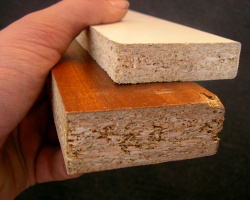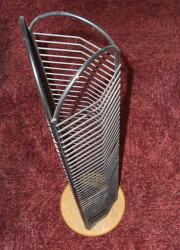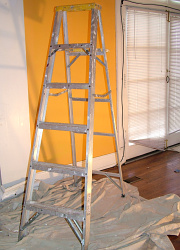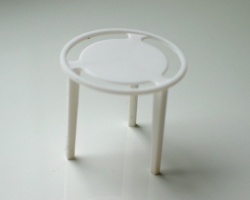How can I reuse or recycle old chipboard/particleboard?
 We’ve had an email from Ben, asking what he can do with some old chipboard/particleboard furniture:
We’ve had an email from Ben, asking what he can do with some old chipboard/particleboard furniture:
The shelves have sagged in the middle so I doubt anyone else would want it.
Most people probably wouldn’t want a saggy bookshelf as a feature in their living room but don’t write it off just yet — it might be fine for shelving in a store room or a garage, particularly if a baton or two can be fitted underneath the warped shelves for extra strength. Offer it on Freecycle/Freegle, describing the condition and see if there are any takers.
Aside from that or if some of the shelves are too far gone, it could possibly be stripped for parts – the uprights could be used for shelves elsewhere – just make sure to use plenty of support so they aren’t as likely to sag.
At the end of its life as furniture/shelving, chipboard can be composted but as it’s held together with synthetic resin, often including formaldehyde, organic gardeners might want to avoid adding it to compost piles destined for veg plots.
For the same reason, chipboard shouldn’t be used on a woodburner or, topically, a bonfire – the formaldehyde and other chemicals used in its production can release toxic gases on burning.
Any other suggestions on things that could be done with old chipboard shelving or bigger pieces of the same? Any more pointers on things not to do with it?
(Picture by Rotor DB)
























I saw an entertainment center turned into a bird cage, so why not turn a bookshelf into a bird cage? For an example look here:
http://handymanrandy.org/images/birdcage_large.jpg
The kitchen in our house is made from this shit – it was fitted only eight years ago according to previous owner, and it’s a well-known quality brand, too, and it’s already disintegrating from the humid climate we have here. I am designing a new kitchen which will be made from old pallets and left over building materials found by recycling stations along the roads, and I will reuse the kitchen doors somehow, as they’re made from real wood, but the rest I’ll leave to the municipality who compost it to use in public parks and when they landscape roundabout islands.
I really can’t think of anything else it’s good for. They really should quit producing this.
It is possible to unwarp the shelves by letting them lay flat with a stack of books or brick or something on top of the “hump” where they warped. Then they can be reused with better support in the middle. If most of the shelving is still pretty flat, they can be cut apart to make storage cubes or something out of the good parts. Particle board can be worked with regular woodworking tools with only minor precautions (like a dust mask and eye protection) that you should be using anyway; most things that can be made of plywood can be made with particle board.
This might go without saying, but don’t ever let it get remotely damp or it will swell out of all recognisable shape and completely disintegrate.
I once threw out a wardrobe made of this stuff, and instead of calling the council for a special !large item” collection I just left it outside for a couple of weeks, by which time it was really soft and easy to snap into pieces small enough to fit in my normal waste bin.
As a general thrifty rule: never buy furniture made of particleboard. Not worth it, even at thrift shop prices. If you are thrifty, buy only wooden furniture, it lasts forever and can be easily remade into other things if needed.